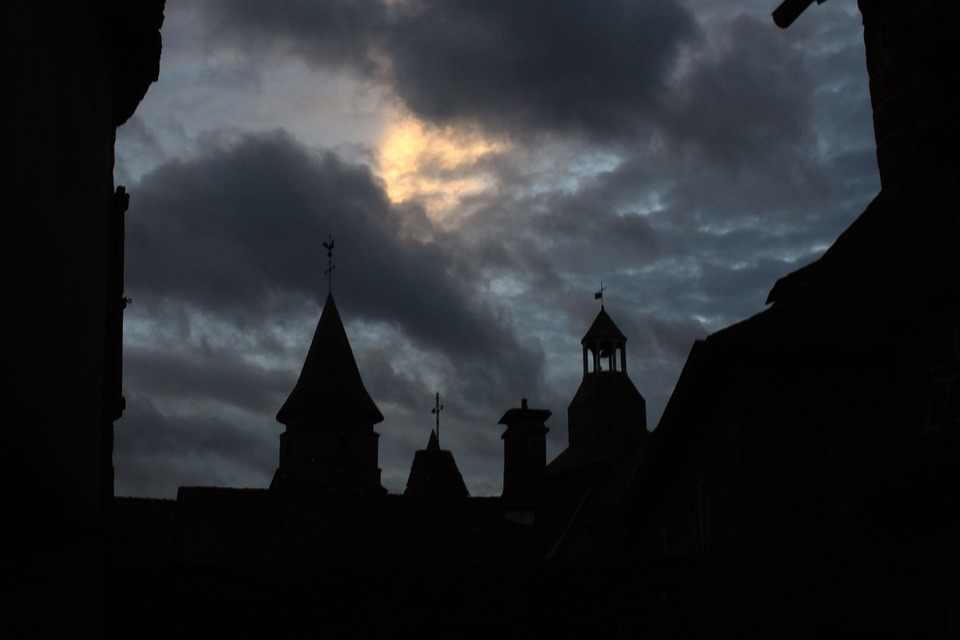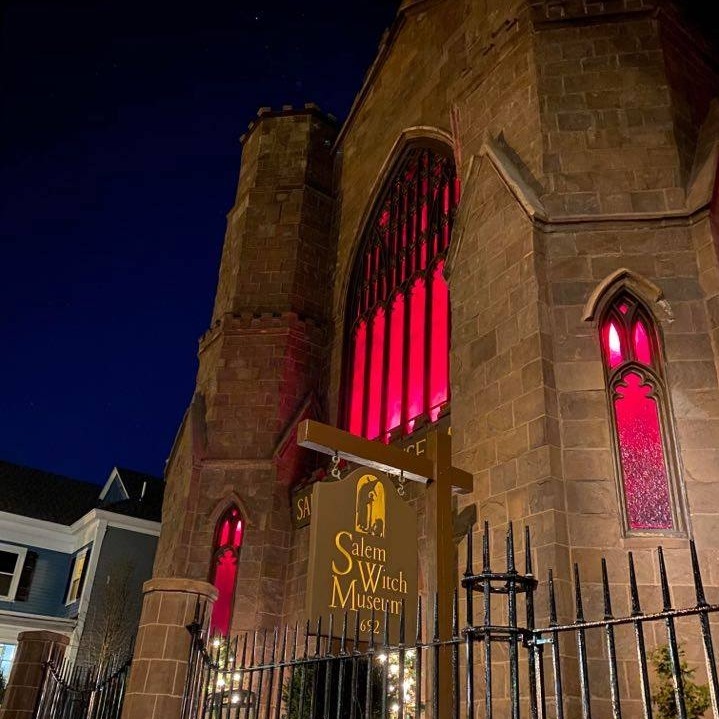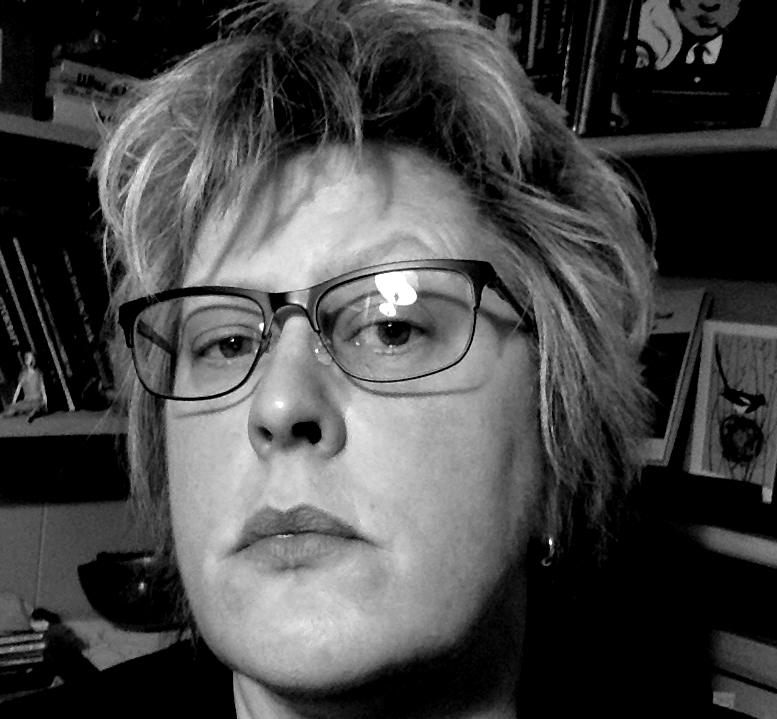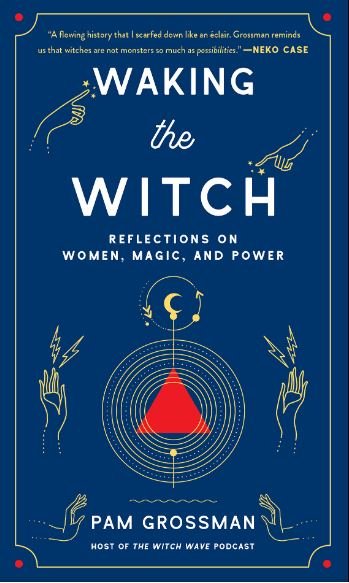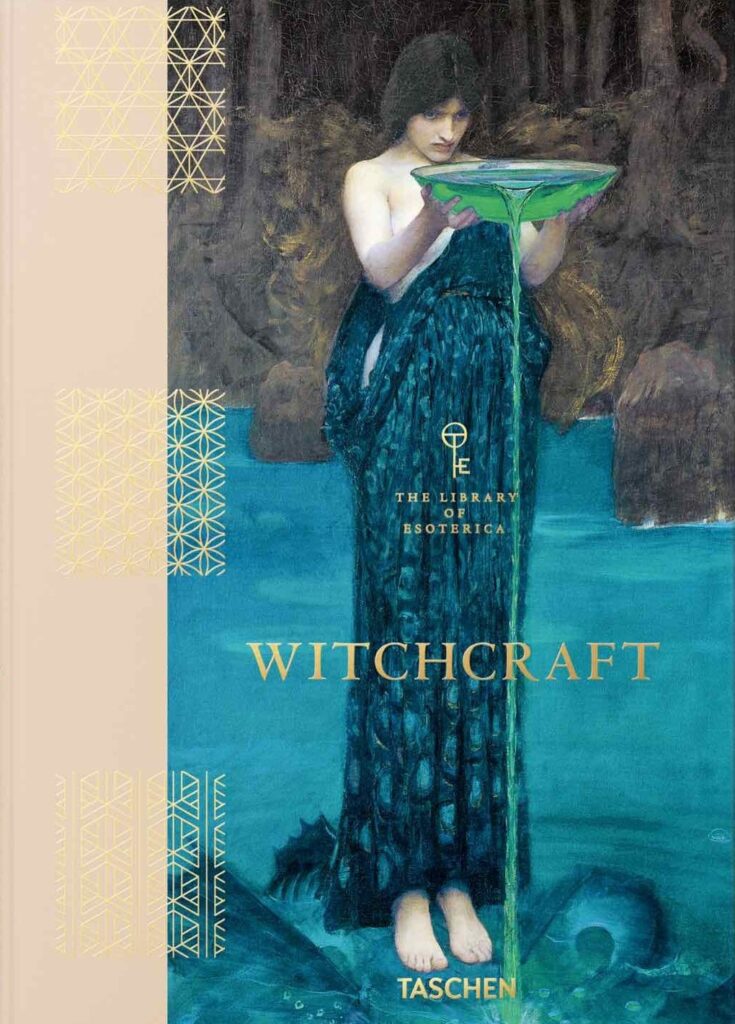
On this week’s 51%, it’s witching hour. We speak with a Massachusetts state senator about a bill to exonerate a woman convicted during the Salem witch trials. Author Kate Laity teaches us about the history of magic, and we also speak with author and podcaster Pam Grossman about modern witchcraft, and why witches are a feminist icon.
Guests: Massachusetts State Senator Diana DiZoglio; Rachel Christ-Doane, director of education at the Salem Witch Museum; Kate Laity; Pam Grossman, author of Waking the Witch: Reflections on Women, Magic, and Power
51% is a national production of WAMC Northeast Public Radio. Our producer is Jesse King, our executive producer is Dr. Alan Chartock, and our theme is “Lolita” by the Albany-based artist Girl Blue.
Follow Along
You’re listening to 51%, a WAMC production dedicated to women’s issues and stories. Thanks for joining us, I’m Jesse King.
The spooky season is upon us, and it’s one of my favorite times of the year. It means pumpkins, apple cider, leaf-peeping — and in upstate New York — a nice reprieve from the humidity of summer before diving into what is usually the months-long chill of winter. It also, of course, means Halloween, and growing up my go-to costume was a witch. I was a witch probably four or five times before I switched over to vampires and the occasional Little Red Riding Hood.
Either I was ahead of the curve, or things really haven’t changed, because despite the popularity of shows like Squid Game and the latest offerings from Marvel, Google’s “Frightgeist” still predicts the most popular Halloween costume in 2021 will be the good, old-fashioned witch.
So today we’re talking about witches: why they’re so popular, what modern witchcraft looks like, and how we got here, because the history of witches in the U.S. can certainly be a difficult read. And where else would we start other than the Salem witch trials? Every year, crowds flock to Salem, Massachusetts to learn more about the 1692, hysterical witch hunt and trials that left 20 people dead. More than 300 years later, groups are still trying to clear the names of everyone convicted.
Democratic State Senator Diana DiZoglio is behind the latest bill, S.1016, to clear the name of Elizabeth Johnson Jr.
“Actually, I heard about Elizabeth Johnson Jr. from a North Andover middle school class. Their teacher, Carrie LaPierre, had reached out to me and said that she and her students had been talking about somebody who was accused during the Salem witch trials,” says DiZoglio. “She had never actually had her named cleared, unfortunately, even though all the others had actually had their names cleared. And I decided to file this bill at the request of the North Andover middle school students.”
Johnson was born around 1670 and lived in a part of Andover that’s considered North Andover today. DiZoglio says S. 1016 would officially exonerate Johnson, adding her name to a resolve in Massachusetts general law that acknowledges that, while the Salem witch trials were lawful at the time, the laws by which they operated have long been abandoned. Until then, however, Johnson is technically the last remaining witch from the trials.
There’s been a lot of speculation about what really caused the Salem witch trials in the first place — whether there were actually “witches,” whether the accusers were outright lying, or whether they suffered from a neurological illness called “conversion disorder,” caused by extreme psychological stress. To learn more, I got the chance to speak with Rachel Christ-Doane, the director of education at the Salem Witch Museum. She says a combination of factors had already put the community under a lot of pressure.
“It’s a pretty chaotic time in Salem Village, and also if we can zoom out, just Massachusetts Bay Colony, generally speaking. Salem Village was in the process of trying to separate from Salem Town in the early 1670s. They had been granted the right to have their own parish, which was a big step towards independence — they could attend to their you know, weekly church meetings a little closer to home. But a factional crisis erupted pretty early on, where half the village likes a ministerial candidate, the other half hates them, and they fight and they fight until they drive that candidate out of town, essentially,” Christ-Doane explains. “By this point, they’re on their fourth minister whose name is Samuel Paris. And he is kind of, you know, not the best in terms of smoothing over the factional divide. He’s a very incendiary figure in and of itself. They’re fighting about what his salary should be, he’s demanding more. It’s basically this kind of mess, you know, in the months leading up to January of 1692.
So basically what starts it all is, in the home of Samuel Paris, we see his daughter and his niece become very ill. So their names are Betty Paris, who’s 9 years old, and Abigail Williams, she’s 11 years old. Betty and Abigail are falling to the ground. They’re screaming, they’re clutching their heads. They’re making animal noises, and nobody can quite figure out what is wrong with the girls. So essentially, they try all the traditional remedies — there’s a month of fasting and prayer and things like that. They call in the village doctor, and he looks at the girls and he says, ‘I don’t have a medical explanation for what’s going on here. It looks to me like this is the work of the devil. This is bewitchment.’ And that’s really what kicks off the witchcraft trials, because now they need to find the witches who are in the community, who are supposedly tormenting these young girls.”
Christ-Doane says the Salem Witch Trials officially took place between June and September of 1692, and anywhere from 150 to 200 people from Salem and its surrounding communities were accused of witchcraft around this time. She says the accused could be any age, race or gender, but at the beginning, at least, they were mostly people who, for one reason or another, didn’t fit in with the rest of society: women who were particularly outspoken, who fought publicly with their husbands, or older “spinsters,” thought to be a burden on the community.
Johnson was one of 28 people in her family to face accusations, including her mother, multiple aunts, and grandfather. Christ-Doane says the political landscape in Massachusetts only contributed to the frenzy. The colony was rewriting its laws and choosing officials as it worked through a new charter, and with alleged witches filling the jails in Essex County, Governor Sir William Phipps created an emergency court to oversee the trials, called the Court of Oyer and Terminer.
“So essentially, they’re told, do what you think is best. You know, base your decisions on English common law and English precedent, but do what you think is right, and what the situation demands. And that, unfortunately, leads to devastating consequences,” Christ-Doane adds. “In the Court of Oyer and Terminer, you have the afflicted — so the girls who are supposedly being tormented by witchcraft — in the room, screaming, falling to the ground, claiming they’re being tormented by the devil. And you as the accused have to defend yourself against this sea of writhing witnesses. And the really destructive decision that’s made by the Court of Oyer and Terminer is their choice to accept something called spectral evidence. Spectral evidence is essentially based on the idea that a witch could theoretically project a spectral version of themselves, a ghostly version of themselves, out of their physical body that could go off across large distances and torment. And the victims of a spectral attack were the only ones who could see the specter. And so that means, if you were accused of witchcraft [and] standing before this court, you could have the witnesses pointing up to the rafters saying, ‘I see the specter of Rebecca Nurse up on the ceiling. You can’t see her, but I can, and that’s how I know she’s a witch.’ And that was being used as enough evidence to convict and warrant executions during the Salem witch trials.”
Ultimately, 20 people were executed for witchcraft: 19 of them hanged, and another tortured to death. Johnson confessed to being a witch and was sentenced to death in 1963, but by then public opinion on the trials had soured. Christ-Doane says almost everyone in Salem had either spent time in jail, or knew someone in jail, and with his own wife among the accused, Governor Phipps disbanded the Court of Oyer and Terminer in October 1962. Johnson’s execution was avoided, and she ultimately died an old woman in 1747, at the age of about 77.
Christ-Doane says the Salem witch trials were the largest and harshest witch trials between England and its colonies — but they were far from the first. Ironically, being called a witch was sometimes more hazardous than the feared wrath of a witch.
But it wasn’t always that way. “Witch history” is hard to pin down, because quite frankly, belief in magic and people with magical abilities has existed for thousands of years, across nearly every culture — and each culture’s definition of a witch is constantly evolving. But there was a time when magic was looked at a little more kindly.
I got the chance to speak with Kate Laity, an award-winning author of several books spanning a range of genres, including Chastity Flame, Dream Book, How to Be Dull, and more. She also produces two audio programs, and while splitting her time between Hudson, New York, and Scotland, she teaches at the College of Saint Rose in Albany. She particularly specializes in medieval studies and literature.
What prompted the start of witch trials in Europe?
Well, especially in the Middle Ages, healing charms, for example — that we would see as sort of magic and not science — they would have seen as effective ways to deal with various kinds of health problems or other problems. There are a lot of journey charms, so you don’t become injured or lost or imperiled on your journey. And there are of course, charms against having your cattle stolen. Again, if you think in old English, the word for “cattle” is also the word for “wealth.” So this is a way of saying, “Don’t steal my stuff.”
This is something that begins to change in the Middle Ages, where you have sort of two strands. There’s the sort of folk magic that most people would be familiar with, and which, you know, continued from pre-Christian times into Christian times, because you just adapted it to the new belief. So instead of maybe praying to this or that god, you would just pray to the Christian God, and you would have masses said over — you know, there’s a wonderful charm for when a field is not producing enough, where you take a piece of it out, and you do a variety of things to it, but then you take it to the church to be blessed, and you pour milk and honey and all these things into the ground, and then you put it back down. That’s a way of restoring the kind of regenerative power that the field should have. But what you also have is a kind of learned magic that is practiced amongst the clergy, which is, you know, the monks who are reading all these books, and many of them during the Crusades, for example, a lot of books were coming up from the middle east through Spain, and a lot of books that were mathematics and more learning kinds of magic that were more about conjuration, about dealing with necromancy and talking to the dead, which was something that was completely alien to the average person.
One scholar, Michael Bailey, argues that in the late Middle Ages, these things kind of get overlapped in a way that matters, because people in power were beginning to worry about unorthodox behaviors within the Church. And this is what in the early modern period — not the medieval, in the early modern period — you start to get the witch hunts.
How common were witch hunts. I mean, we talked about the Salem witch trials, but worldwide, how common were they?
We find this in in many of those occasions where there are sort of pressures on the society that people don’t have a way of coping with — instances that, you might just say, are acts of God. But the way that people respond to them is, “Somebody’s got to pay. Somebody’s got to be to blame for this.” So, “Well, she’s a witch, or he’s a witch.” And again, depending on the region — we’re accustomed to associating witches with women, but in some areas in European history, in Finland and in Iceland, the greater part of the accusations were against men. And part of that is to do with very long histories of gendered magic in Iceland and Finland, where there’s magic practice by men and magic practice by women, and they’re quite distinct.
How are they different?
Especially in Iceland, which I’ll talk about as its at the top of my mind, women’s magic tends to be focused much more on prognostication. So they can see, they can see what is coming or they can see what has happened. Men and women both are able to read dreams. And one of the interesting aspects of Norse Mythology is that the figure of Odin is one of the few that practices both —what is considered the male magic and the feminine magic.
Where does the word “witch” come from?
The word witches is a very, very old English word. People will say it has to do with bending, it has nothing to do with bending. That’s a completely different word root. And what it has to do with is witchcraft. We have the earliest attestation of it in Old English. I mean, this is in the oldest versions of English, and it comes from an Indo-European root, but it’s always meant exactly that. And that’s where the word “wicca,” which many people will be familiar with, is just the old English word for witch. There’s “wicca” with an A and “wicce” with an E. So we have a masculine and feminine version of it, but it’s the same word.
So obviously, during these times, you’ve got people being accused of witchcraft. But is it common for people to identify like, “I am a witch?”
Well, probably not at the time they were being accused. I mean, you would have women who might be practiced in certain arts, that they’re able to heal people. Maybe they have a knowledge of herbs that’s been handed down, usually these things are handed down within families or learned from somebody else older. And so they have abilities to do this. And of course, the idea of cursing is something that’s always probably been with us too. And if you look at the long history of magic, it’s fascinating how many of these tangible forms [exist] — especially when you’re angry, a lot of magic is about anger, because it comes from the idea of people who want something to happen, and don’t feel they have any power to be able to make it happen. And so if you look in ancient Greek and Roman cultures, we have all these lead tablets with curses written on them. We’ll still find somebody being cursed to this day because their tablet has been found, and we don’t always know who these people were, but somebody was obviously really mad that day.
Do you identify as a witch?
Usually, it depends on the mood. But yes, in large part because I’ve got all this history in my mind, and I see a great power in claiming that name. And also as a way of thinking about how you approach the world. I mean, part of this is tied to to my creative work — not only writing, but also art and music that I do, that it comes from this idea of reenchanting the world and and finding that magic in everyday life.
So how did we go from the Salem witch trials, to the top of the rankings on Frightgeist? And beyond costumes and All Hallow’s Eve: for years now, if you search for information on witchcraft, you’ll find articles signalling its rise. More and more people, of all genders, are actively identifying themselves as witches, with estimates putting the number at around 1.5 million witches in the U.S.
Nowadays, you can buy professional witch services online, from tarot readings to rituals. You can have supplies for spells delivered right to your door. Witches are social media influencers, they’re authors and podcasters, they’re activists and symbols of feminine power. They might don the black hat and carry around a broom when they feel like it – but they’re also your coworker, and your neighbor.
Pam Grossman has written and contributed to several books on witchcraft, including her 2019 book, Waking the Witch: Reflections on Women, Magic, and Power, and her new release with Jessica Hundley, titled simply, Witchcraft. Since 2017, she’s also been the host of the popular podcast, The Witch Wave, for which Vulture dubbed her, “the Terry Gross of witches.” I asked her why witches seem to be having their moment, and she says it’s really been hundreds of years in the making.
How did the perception of witches change to what we see today?
Well, we first start to see a more sympathetic look at witches, really, in the 19th century. There were writers such as a French writer named Jules Michelet, who wrote a book called La Sorciere in the middle of the 19th century, who was following a lot of other scholars who were starting to look back at the witch hunts with a more sympathetic lens. It wasn’t an always historically accurate lens, mind you, but you know, people would start to look back at the witch hunt and say, “Hey, wait a second. It was mostly women who were targeted? And what was it about these women that made them such a threat to the Church?” And so, you know, around that time, you’ll see writers who talk about witches as these oppressed, but truly powerful, women who had access to these brilliant minds or some kind of supernatural intuition or some kind of magic power. And aren’t those women amazing? And they shouldn’t have been persecuted, according to those 19th century writers. As we now know, you know, those people who were killed for being witches probably were not actually witches, or probably did not see themselves as witches. However, that sympathetic notion of a witch being this oppressed woman who has access to some divine feminine energy is a very romantic notion, that feminists took up in the 20th century. And so we really start to see people choose to call themselves witches in the 20th century, certainly with second wave feminism, but also with the rise of Wicca, which is a modern religion that was largely founded by a gentleman in England named Gerald Gardner. And the Wiccan movement is a whole very interesting thread to this story, too.
In your book, you say that you’ve used the word “witch” to signify that you’re a feminist. Can you go into a little bit about what you mean by that?
Well, I think both the word “witch” and the word “feminist” are highly charged words. And they are words that point to having access to some kind of power, or some kind of agency that is connected to the feminine. And so the words are not interchangeable, but for me, and many other witches, they are interrelated. Because witches usually represent an antithesis to the patriarchy. They represent everything that is othered in society — and that can be having a feminine body, or a body of color, or a trans body. It can be having access to some kind of intuitive power or other worldly power that I believe can coexist happily with science and medicine. Certainly not the same as those things, and can be considered an alternative or a supplement or complement to those more mainstream practices. But for me, the two words are very deeply woven together.
So what does being a witch look like to you? Because one thing I’ve learned is that everyone seems to have their own interpretation.
Yes. One of the wonderful things about modern witchcraft is that there is no one path and it’s decentralized. In other words, there’s no pope of witchcraft. There’s no one book that one has to read in order to call oneself a witch. And so you’re right, for every witch you ask, you are going to have a different answer about why they consider themselves a witch, or how their witchcraft practice works. In my case, I am Pagan. I was raised Jewish, so when I’m being cheeky, I sometimes call myself “Jewwitch.” But, you know, being a practicing Pagan essentially means that I am celebrating the different changing of the seasons. I am celebrating different phases of the moon. I have an altar where I connect with what I call capital S Spirit, and that can take the shape of various deities, who symbolize different aspects of that Spirit. And it also means that I do cast spells and engage in rituals that are deeply meaningful and transformative for me.
When did you realize you’re a witch? Or at least when did you start getting more into it?
So I definitely considered myself kind of magical since I was a child. I had these woods in my backyard, and I would play outside like a lot of kids do and, you know, cast spells and commune with different spirits and so on. Or at least I imagined that I was. But it wasn’t until I was a teenager and discovered witchcraft books and the occult section of the library in different bookstores and New Age shops, that I really learned that witchcraft was something that you didn’t have to pretend that you were engaging in. That there’s actually a long history of people who have practiced some form of witchcraft. You’ll actually hear that a lot — that the teen years are a time that a lot of people turn towards witchcraft. And I think it’s no coincidence, because it’s also a time of life when we’re coming into our own power, our own identity, and looking for ways to feel like we have more agency in our lives — at a time when we don’t, in a lot of ways. We still have to answer to our teachers and parents and peers. And then along comes this practice that says, “You have power right now. You know, you have access to something bigger than yourself, even as a 13-year-old. And for me, learning about witchcraft as a teenager was an incredibly positive thing.
For those who might be interested in learning more, where should they start? You mentioned that you started a lot by just reading books.
Oh my goodness, there are so many books on witchcraft now, it’s a real feast. But it can also be overwhelming for people because they don’t know where to start. So you know, there are certainly wonderful books that came out when the second wave of feminism was cresting here in the U.S. that I still think have value. One such book is The Spiral Dance by Starhawk, who really is one of the pioneers of earth-based and Goddess-based witchcraft here in the U.S. And that book still stands the test of time, I think there’s a lot of beauty there. And also the same year that that book came out, which is 1979, is a book called Drawing Down the Moon, by actually a radio journalist who was also a Wiccan priestess, named Margot Adler. And this is a wonderful overview just on the history of the witchcraft movement, and all of the different groups that have made up this movement over the years. So those two are really great foundational texts. But then in terms of casting spells, just go to a bookstore and figure out what’s calling to you, you know, we’ve all had that experience of picking up a book and just kind of getting that rush of excitement or, or feeling like it’s a homecoming. So whatever book gives you that feeling is the right book to start with.
Are there a simpler spells and charms that are good for beginners?
Ooh, that’s a that’s a really lovely question. Certainly, candle magic is a simple way of casting a spell, and it’s one of the most accessible. You don’t even have to get a fancy special candle at a witchcraft store, you can get any old candle at a grocery store, and as long as you’re putting your intentions into it, there’s a good chance it’s going to be really effective for you.
Overall, what do you think people misunderstand about witches?
I think one of the most common misconceptions is that if you are a witch, that means you have to reject what other religion of origin you might have been raised with. And that’s simply not true. Yes, there are some people who were raised with a religion that they might have found oppressive or even harmful, and so they might reject that religion and turn towards witchcraft. But that is not everyone’s story. There are Christian witches and Jewish witches and Buddhist witches and Hindu witches and Muslim witches and so on. So, being a witch can absolutely be complimentary to other spiritual paths that you might be walking.
The other most common misconception, which I almost hesitate to bring up, because it’s really bad PR, is the notion that witchcraft is somehow affiliated with the Devil and diabolism. And nothing could be further from the truth. Most witches are incredibly loving, kind, nature-worshipping, or at least nature-honoring, people. And the reason that people sometimes associate witchcraft with some kind of evil comes right out of the time of the witch hunts. You know, we’re talking the 15th-17th centuries in Europe, and later here in what became the United States. And that is when this idea that witches were devil-worshipping and sexually deviant and murderous, and all of the horrible things and reasons [came about], that they use to rationalize killing innocent people. Unfortunately, those stories and those horrific beliefs are still sometimes with us today. We do see that in discriminatory practices against people who identify as witches, and there are still witch hunts that happen around the world today. Literal witch hunts. It’s deeply, deeply damaging and couldn’t be further from the truth.
Looking back on the Salem witch trials, as Grossman noted, most of those accused probably weren’t actually witches. Lying by confessing to witchcraft and turning in other “witches” increased one’s odds of avoiding execution. Some of the convicted eventually petitioned for exoneration in the 1700s, and up until the early 2000s, various groups have worked to redeem those who remain.
But how did Elizabeth Johnson Jr. get left out? How did we get here?
State Senator Diana DiZoglio says, unlike some of the others who were wrongfully convicted, Johnson didn’t have any descendants to push for her exoneration. She never married, she had no children, and some historians have suggested that she may have been mentally disabled. DiZoglio says it could still take a while for Bill 1016 to make its way through the Massachusetts Senate, but she’s optimistic it’ll pass – and it’s good for all parties involved.
“You know, this is something that’s a matter of equality and making sure that justice is served. I commend these students for taking their civic education course to the next level,” says DiZoglio. “This is something that demonstrates their ability to speak up and be a voice for the voiceless, and I think that that carries over into all different issues that they’re going to be able to advocate for going forward. And I think it demonstrates that, no matter how young [you are], you can make a difference.”
You’ve been listening to 51%. 51% is a national production of WAMC Northeast Public Radio. I have so many people to thank for this episode: State Senator Diana DiZoglio, Rachel Christ-Doane with the Salem Witch Museum, Kate Laity, Pam Grossman, our executive producer, Dr. Alan Chartock, and of course you for tuning in. On social media, we’re on Twitter and Instagram at @51percentradio. Let us know what you think, and if you have a story you’d like to share as well. Until next week, I’m Jesse King for 51%.
